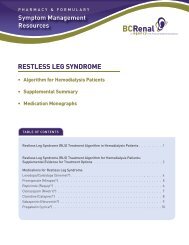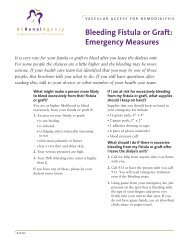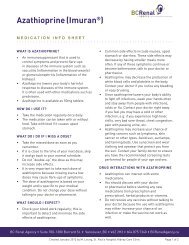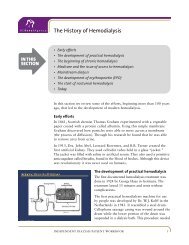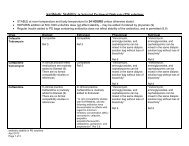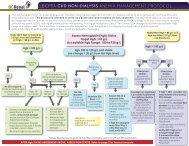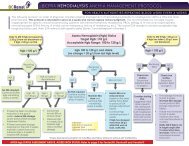Vascular Access Module #3: AVF Maturation ... - BC Renal Agency
Vascular Access Module #3: AVF Maturation ... - BC Renal Agency
Vascular Access Module #3: AVF Maturation ... - BC Renal Agency
Create successful ePaper yourself
Turn your PDF publications into a flip-book with our unique Google optimized e-Paper software.
<strong>Module</strong> <strong>#3</strong>:<strong>AVF</strong> <strong>Maturation</strong>, Needling &Complications» <strong>AVF</strong> <strong>Maturation</strong>» <strong>AVF</strong> Needling» <strong>AVF</strong> Complications68
<strong>AVF</strong> <strong>Maturation</strong>: Case StudyReturning to the case…..• Mr. Kline is now 8 weeks post-op & still dialyzingwith his catheter.• He should have a mature fistula after 8 - 12 weeks.• You wonder if you can start needling.69
<strong>AVF</strong> <strong>Maturation</strong><strong>AVF</strong> maturation = process by which a fistulabecomes suitable for cannulation (i.e. developsadequate flow, wall thickness, & diameter).Reference: “<strong>Vascular</strong> Anatomy for HD” by Lawrence M. Spergel, MD - <strong>BC</strong> VAEG<strong>Vascular</strong> <strong>Access</strong> Workshop May 2008.70
<strong>AVF</strong> <strong>Maturation</strong>1. What are the goals of maturation/needlingassessment?Rule of “6s”: A mature fistula should be:– >6 weeks old (minimum)– >6 mm in diameter with discernible margins when tourniquet applied– 6 cm long– >600 mL/min for access blood flowAny <strong>AVF</strong> that does not meet the above criteria should beevaluated for non-maturation 4-6 weeks after creation.References:Core Curriculum for Nephrology Nursing“<strong>Vascular</strong> Anatomy for HD” by Lawrence M. Spergel, MD - <strong>BC</strong> VAEG <strong>Vascular</strong> <strong>Access</strong> Workshop; May200871
<strong>AVF</strong> <strong>Maturation</strong>2. How do we know if it is OK to start needling?• Arterialization of vein wall due to increased blood flow» Ideal access flow 800-1200 ml/min» Vessel should be soft & compressible» As the vessel becomes more arterialized, the rebound after compressionshould be stronger.• Thrill should feel like a vibration or purring• Bruit should be a continuous whooshing sound• Vessel depth & size should be appropriate:i.e. >6 mm diameter &
<strong>AVF</strong> <strong>Maturation</strong>:Assessory Vessels & Embolization73
<strong>AVF</strong> <strong>Maturation</strong>3. What are the tools required for this assessment?– Physical Assessment• Look• Feel• Listen– Comparison to other limb– VAN or Advanced Cannulator: Ultrasound to map the fistulafor cannulation (site-specific policy)– VA History:• Documented history of maturation over time• 2 & 6 week follow up appt entered into PROMIS along withobservations74
True or False?<strong>AVF</strong> <strong>Maturation</strong>If the access is not mature by 8 weeks, then Mr. Kline shouldbe seen by the vascular access team.TrueFalseTrue• May need to have radiological intervention vs. surgery.• Generally, if on dialysis: maturity of 4 – 6 weeks is required beforeany radiological intervention is consideredA weak thrill should be palpable at the anastamosis, increasingcloser to the venous end.TrueFalseFalse75
<strong>AVF</strong> Needling: Case StudyReturning to the case…..• Mr. Kline still has a functioning CVC. He isallergic to chlorhexidine & alcohol swabs.• Mr. Kline’s access is ready for needling. Youare going to needle him today.76
<strong>AVF</strong> NeedlingPlenty of choices for sitesHealing anastamosisArterialized cephalic veinBeautiful development of a radio-cephalic <strong>AVF</strong>77
<strong>AVF</strong> NeedlingHow will you prepare the access arm for needling?Recommendation: Needle first, then prepare the CVC (morelogical & efficient)• Ask Mr. Kline to wash his hands & <strong>AVF</strong> arm using soap & water.• Map out the cannulation site for one fistula needle (How wouldyou do this?)• Clean cannulation site with site-specific germicide solution usingcircular motion, starting at needle site & moving outward.• For Mr. Kline, use Amuchina because he is allergic to CHG &isopropyl alcohol.• Allow germicidal solution to dry for 1 minute.78
<strong>AVF</strong> NeedlingWho should needle this new access?Novice? Skilled? Advanced?Initially, we will use the CVC port for the venousreturn & the fistula needle for the arterial pull.The access needle insertion site & needle tip must be3 – 5 cm away from the anastomosis.Use a 17g needle for the fistula cannulation.79
Is This an Easy <strong>Access</strong> to Needle?Brachio-cephalic <strong>AVF</strong>On inspection it looks easy? But is it?80
Is This an Easy <strong>Access</strong> to Needle?NO, it is not easyArterial needleAnastomosisVein mapping to identify flow pattern.Venous needle81
<strong>AVF</strong> Needling: Vein MappingResult: Moderately complicated.82
<strong>AVF</strong> Needling: Vein MappingResult: Complicated. Only one viable needle spot per this assessment.
<strong>AVF</strong> Needling: Watchful Eyes• “SLEEVE UP” may reveal morethan a nicely developingaccessory vessel …• It may also reveal a seriouscomplication.• This sleeve stayed down forseveral months without apeek. The vessel had not yetbeen used.• This speaks very strongly tothe value of nurses beingdedicated to VA monitoring.
<strong>AVF</strong> Needling:Using a Teflon Needle(a less familiar option)A<strong>BC</strong>
<strong>AVF</strong> Needling: Using a Teflon NeedleThe cathlon cannot move off thestylet when held in this manner.
<strong>AVF</strong> Needling: Using a Teflon NeedleNote the flashback in the stylet – this will show first. Theblood will then track up the cannula. Once this occurs,the cannula can then be eased off the stylet. Only afterthe cannula has been advanced into place may the styletbe removed.Q: What’s wrong in this picture?A: The gloves – there are none!A: Stylet is not prevented from moving.
<strong>AVF</strong> Needling:It Doesn’t Have to be a YOUNG Arm
<strong>AVF</strong> Needling: Just a Nice Picture
<strong>AVF</strong> Needling:Cannulation Trouble-shooting• Check your body position• Check the patient’s position• Re-angle the depth of the needle• Re-angle the position of the needle to the access• Tourniquet• Check patency• Rotate wings of needleWhat are your tips?90
<strong>AVF</strong> Needling:Cannulation Trouble-shootingYou were unsuccessful in your first needling attempt.What will you do now?• Remove needle; apply pressure to stop bleeding;then ice to minimize swelling.• Use CVC only & rest <strong>AVF</strong> for 1-2 weeks (untilswelling & edema have subsided).– Reassess condition of <strong>AVF</strong> at next treatment.• Educate patient re ice/ heat application.– Ice x 24 hours, then warmth after that (heating pad onlow or use warm, wrapped hot water bottle).91
<strong>AVF</strong> Complications• Stenosis, including Juxta-anastomosisstenosis (JAS)• Infiltration• Infection• Aneurysm• Skin breakdown
<strong>AVF</strong> Complications: Case StudyReturning to the case…..Mr. Kline has been dialyzing with his fistula for 6months with no problems.Today, he asks if you can get the surseal ready as ithas been taking a long time to stop the bleedingfrom the arterial site the past few runs.What should you do?93
Chart review reveals:<strong>AVF</strong> Complications• Hematoma• Problems with venous cannulation• Occasional arterial supply problems• Frequent clotting of extracorporeal circuit• Prolonged bleeding post dialysis at arterial site• More negative arterial pressures over 3 consecutive runs• A drop in access flow of > 20% from the baseline• Decreasing blood clearance values94
Case Study: <strong>AVF</strong> ComplicationThe problem is……?Juxta-anastomosis Stenosis (JAS)What are the possible causes?• Trauma during surgery (damage to the vessel intima)• Scarred vessels due to blood draws, IVs, IV drug use• Diseased vessels due to diabetes, PVD, CAD, etc• Sclerotic vessels due to chemo, steroids, mineral(calcium)953
<strong>AVF</strong> Complication: JASRC anastamosisJAShttp://www.nature.com/ki/journal/v64/n4/thumbs/4494044f1ath.gif96
<strong>AVF</strong> Complication: JASWhere would you expect a juxta-anastomosis stenosisto form on the access?• Within 5 cm distal to the anastomosis2 year old RC <strong>AVF</strong> which has never been needled97
<strong>AVF</strong> Complication: JASJAS<strong>BC</strong> <strong>AVF</strong>JAS98
<strong>AVF</strong> Complication: StenosisWhat is the problem with Mr. Kline’s fistula?• Possible stenosis.What are the causes of stenosis formation?• Repeated blows/ hematomas.• Scarring due to “one sititis.”• Scarred vessels due to blood draws, IVs, IV drug use.• Diseased vessels – diabetes, PVD, CAD, etc.• Sclerotic vessels – chemo, steroids mineral (calcium).• Repeated Percutaneous Transluminal Angioplasty .Repeated poking +++ trauma!996
<strong>AVF</strong> Complication: StenosisWhy are stenoses important to detect?• Inefficient dialysis: declining bloodclearance.• Blood loss due to increased venouspressure & prolonged bleeding.• Inadequate blood pump speed may lead toclotting in circuit.• <strong>Access</strong> can clot.1004
<strong>AVF</strong> Complication: StenosisWhy are stenosis’ important to detect?• Ineffective dialysis.• Difficulty cannulating patient discomfort.• Blood loss due to increased venous pressure & bleeding.• Clotting in circuit if inadequate BPS.• Recirculation, PRU, Kt/V, IDY.• <strong>Access</strong> may thrombose.Common locations for stenosis formation• Juxta-anastomosis stenosis (reviewed as an early comp’n).• Anywhere along the outflow tract .• Cannulation sites.• Brachiocephalic arch.• Central venous stenosis – catheter placement.101
<strong>AVF</strong> Complication: StenosisHow will you detect the presence of stenosis onthe access arm?Look for:• Hard dilated veins, swollen hand/arm.• Lift arm – look for vessel to dilate before thestenosis; easier to see with a R-C <strong>AVF</strong>.• Aneurysmal areas.• If central stenosis – look for arm edema; collateralvessels along the chest wall.102
<strong>AVF</strong> Complication: StenosisHow will you detect the presence of stenosis on theaccess arm?Feel for:• Dilated veins without compression.• Hardness before the stenosis & may be difficult to palpateafter the stenosis.• Narrowing of the vessel.• Thrill which is stronger before & disappears after thestenosis .– The closer the stenosis is to the anastomosis the more bounding &pulsatile it will feel (juxta-anastomatic stenosis).103
<strong>AVF</strong> Complication: StenosisHow will you detect the presence of stenosison the access arm?Listen for:• Change in sound of the bruit …– Very loud & bounding (water hammer).– High pitched &/or whistling quality whichdisappears distal to the stenosis.– Heard only on systole (severe stenosis).104
<strong>AVF</strong> Complication:Venous Stenosis or OcclusionBruitNormalCollapses partially orcompletely when arm orleg elevatedVenous Stenosis- Low pitched- Continuous- Diastolic & systolic- Aneurysmal dilatations oftenappear below stenotic siteBeathard G. Fistula First National <strong>Vascular</strong> <strong>Access</strong> Improvement Initiative. A Practitioner’s Resource Guide toPhysical Examination of Dialysis <strong>Vascular</strong> <strong>Access</strong>. November 2003.105
<strong>AVF</strong> Complication: StenosisParameter Normal StenosisThrill- Only at arterialanastomosis- At site of stenoticlesionPulse- Soft, easilycompressibleBeathard G. Fistula First National <strong>Vascular</strong> <strong>Access</strong> Improvement Initiative.A Practitioner’s Resource Guide to Physical Examination of Dialysis<strong>Vascular</strong> <strong>Access</strong>. November 2003.-Water hammer-Firm & pulsatileproximal to stenosis-Portion of veinperipheral to stenosisstays distended ¢ral portion of veincollapses106
<strong>AVF</strong> Complication: StenosisStenosis & occlusion107
<strong>AVF</strong> Complication: ??Same arm: 2 nd viewSame arm: rotatedTo be avoidedcollateral development108
<strong>AVF</strong> Complication: ??Same arm: 3 rd viewAlternative areas to cannulate109
<strong>AVF</strong> Complication: StenosisAreas of stenosis developed due to cannulation in same areas110
<strong>AVF</strong> Complication:Diagnosis of Stenosis or OcclusionFistulogram• Puncture fistula with small gauge needle.• Inject contrast.• Visualize fistula from arterial anastomosis tocentral veins.• Reflux of contrast into artery during injectionnecessary to examine arterial anastomosis &arterial limb.111
Stenosis in Basilic Vein BetweenAneurysmal Dilations© Janet Graham112
Stenosis in the Cephalic Vein of aRadiocephalic AV Fistula© Janet Graham113
<strong>AVF</strong> Complication: Stenosis inRadiocephalic Fistula (Multiple Areas)© Janet GrahamWhere will you needle & why?What pressures would you expect to see from yourchoices?114
<strong>AVF</strong> Complication: StenosisWhere will you needle & why?Stenosis:– Venous: Above stenosis to prevent increased venous pressure– Arterial: Away from or retrograde to stenosis to prevent inadequate flowproblemsWhat pressures would you expect to see from your choices?Regular outflow vein stenosis: pressures will depend on where needles areplaced:– Arterial needle BELOW stenosis – more positive arterial pressures– Arterial needle ABOVE stenosis – more negative arterial pressures– Venous needle BELOW stenosis – more positive venous pressures– Venous needle ABOVE stenosis – normal venous pressures115
<strong>AVF</strong> Complication:Stenosis - Management with Angioplasty• Venous stenosis does not respond as well toangioplasty as arterial stenosis• Guidelines recommend treatment ofstenosis ≥ 50% reduction of normal vesseldiameter accompanied by hemodynamic,functional or clinical abnormalityJindal K, et al. J Am Soc Nephrol 2006;17:S16-23;National Kidney Foundation. KDOQI Clinical Practice Guidelines & Clinical Practice Recommendations 2006Updates: <strong>Vascular</strong> <strong>Access</strong>. Am J Kidney Dis 2006;48(suppl 1):S1-S322.116
<strong>AVF</strong> Complication:Stenosis – Management with AngioplastyShort vascular sheath insertedGuidewire advanced into fistulaNormal vein proximal to stenosis or distal topost-stenotic dilatation measuredAngioplasty balloons inflated for ~ 20 – 30 secondsBalloon removed & another angiogram performedIf residual stenosis > 30%, angioplasty repeated with larger balloon117
Fistulogram with Mapping NotesRecommend venousbuttonhole site, just belowor in front of aneurysmhump.Recommend potential arterialbuttonhole sites. Try to avoidgoing through scar tissue.118
Fistulogram Thigh <strong>AVF</strong>119
Pre- & Post-angioplasty of Severe Stenosisabove Arterial Anastomosis inRadiocephalic FistulaAreas of arterial anastomosis © Janet Graham120
Endovascular Stent PlacementRadiocephalic FistulaAreas of arterial anastomosis © Janet Graham121
<strong>AVF</strong> Complication:InfiltrationEvery nurse’s worry when needling abrand new fistula• Edematous upper arm.• Extensive bruising at the ACF where the firstneedle was attempted.This may have blown:• as the needle entered the vessel (still fragile).• as the needle was flushed with the syringe• as the blood pump was started• mid run due to patient movement or off-centreneedle placement• post run with pressure rebound after site washeld122
<strong>AVF</strong> Complication: Infiltration123
<strong>AVF</strong> Complication: InfiltrationThe problem is…..?Needle infiltrationWhat would expect to notice during yourassessment?• Swelling, bruising• Complaints of pain & tenderness124
<strong>AVF</strong> Complication: Needle InfiltrationNeedle Infiltration with immediate bruising & swelling.125
<strong>AVF</strong> Complication: Needle InfiltrationWhat do you do?• Hold site – including where needle tip was – with two fingers or moreuntil hemostasis achieved.• If suspect ‘back-blow’ infiltration, use c-clamp digital pressure.• Apply ice immediately after hemostasis & ask patient to reapply ice athome for 20 minute periods at least once an hour for next 24 hours.Heat or warmth can be applied thereafter.• Patient may take acetaminophen for discomfort.• Assess access for degree of hematoma at the time of infiltration & at thenext run to determine severity & level of needling skill required.• Needle away from hematoma site until hematoma resolved.126
<strong>AVF</strong> Complication: Needle InfiltrationWhat would you expect to hear during auscultation?• Presence of bruit – low & continuous.• May be diminished if large amount of swelling or high pitched ifmoderate to large amount of swelling.What would you expect to feel during palpation?• Hardness (induration) over bruised area (due to infiltrated blood) -inappropriate for cannulation.• Vein less palpable.What should you look for that would allow cannulation?• Presence of a thrill.• Soft compressible area appropriate for cannulation.**Check for other nearby vessels that have developed under theinfluence of overall increased blood flow.**127
<strong>AVF</strong> Complication: Needle InfiltrationWhere will you needle & why?1. “Above bruise” = venous.2. “Above/ below bruise” = arterial.Rationale:• Cannulate away from the infiltrated site to allow forhealing.• If cannulate into or below traumatized area & infiltrationoccurs, will just further traumatize with possibility ofcausing compartment syndrome & thrombosis.128
<strong>AVF</strong> Complication: Back Blow Infiltration129
<strong>AVF</strong> Complication: Back Blow InfiltrationHow Can You Prevent?130
<strong>AVF</strong> Complication:What is the Problem?131
<strong>AVF</strong> Complication: InfectionWhat do you notice on assessment?• Redness• Possible edema• Discharge• Pain & tenderness132
<strong>AVF</strong> Complication: InfectionHow could it have happened?• Previous needle sites have not healed• Ineffective cleaning technique• Improper cannulation technique• Scratching/compromised personal hygiene(especially of fingernails)133
<strong>AVF</strong> Complication: InfectionWhat might you expect to hear duringauscultation?• May be no change in bruit if swelling is minimal• Diminished bruit due to swelling (especially ifextensive)What might you expect to feel duringpalpation?• Vein may be less palpable• Tissue hardened due to swelling• Tissue warmth due to inflammatory process134
<strong>AVF</strong> Complication: InfectionWhere will you needle & why?IT IS NOT ADVISABLE TO NEEDLE INFECTED <strong>AVF</strong>Check with MD – may need temporary CVC• <strong>AVF</strong> may be salvaged with antibiotics• a line may need to be insertedIf MD determines <strong>AVF</strong> can be needled:• Needle away from infected area135
<strong>AVF</strong> Complication: InfectionWhat to do?• Observe for drainage & swab for culture• Note presence of pulses, bruit & thrill• Document; if possible photograph• Monitor patient temperature• Contact doctor before needling• Avoid infected sites when needling• Pain management as required• Coach patient re hygiene & access care136
<strong>AVF</strong> Complication:Buttonhole Infection137
<strong>AVF</strong> Complication:Buttonhole InfectionDue to Repeated Needling of Buttonholewith Sharp Needle138
<strong>AVF</strong> Complications: Case StudyReturning to the case…..Mr. Kline has been dialyzing with his fistula for12 months with no problems.You notice that the dynamic venous pressure atQb 200ml/min is 200mmHg. You review thedocumentation on the chart & find problems.139
<strong>AVF</strong> Complications: Case StudyMr. Kline’s chart reveals:• Needling difficulties• Flashback of “black” blood• Clotted needle• Lack of supply• Hematoma formation• Frequent clotting of extracorporeal circuit• Prolonged bleeding post dialysis• Aneurysm• Trend of elevated dynamic venous & arterial pressures (over 3consecutive runs)• A drop in access flow of > 20% from the baseline• A drop in Diascan KT/V (from 1.3 to 1.0); PRU 72% reduced to 60%• IDY of 130 @ qB of 350 mL/min; previously 180140
Fistulogram ExamplesBUpper armAForearmFistulogram reveals a problem. Can you identify it?141
<strong>AVF</strong> Complication: Aneurysm142
<strong>AVF</strong> Complication: Aneurysm143
<strong>AVF</strong> Complication: SpontaneousRupture of an Aneurysm144
<strong>AVF</strong> Complication: Skin BreakdownThinned skin.Risk of rupture& prolongedbleeding.Avoid!145
<strong>AVF</strong> Complication: Skin BreakdownAvoid using Tegadermin this area146
<strong>AVF</strong> Complication: Skin BreakdownSkin breakdown & rupture due to repeated cannulations147
<strong>AVF</strong> Complications• Needling difficulties• Flashback of “black” blood• Clotted needle• Lack of arterial supply• Vessel spasm• Hematoma formation• Frequent clotting of extracorporeal circuit• Prolonged bleeding post dialysis• Trend of elevated dynamic venous & arterial pressures (over3 consecutive runs)• Drop in access flow of > 20% from the baseline• Increase in recirculation to 20%• Drop in values that measure clearance148
<strong>AVF</strong> Complication:Needling Difficulties & FlashbackList possible causes of:• Needling difficulties– Patient or nurse position or posture– Needle not in alignment with vessel– Incorrect needle depth– Incorrect needle length– Tip of needle not in vessel centre– Scar tissue– Vessel aneurysmal• Flashback of “black” blood– Clotted access– Cannulation of pseudoaneurysm149
<strong>AVF</strong> Complication:What could of caused this?We must notforget thepossibility ofexternal injuryunrelatedto the patient’stime in the HDunit.
<strong>AVF</strong> Complication:What could of caused this?Answer: scraping the scab off a BH instead of picking the scab off
Case Study: <strong>Access</strong> MonitoringState possible causes of (cont’d):• Clotted needle– Not in vessel– Repeated poking– Took too long to access the access– Cannulated into a pseudoaneurysm that contained clotted blood– Needle placed incorrectly in the vessel (i.e. upagainst the wall)• Lack of arterial supply– Arterial stenosis– Cannulated arterial needle above a stenosis– Small vessel needle gauge too big therefore may be sucking upagainst vessel wall– Needle placement incorrect– Hypotension, hypovolemia152
Case Study: <strong>Access</strong> MonitoringState possible causes for (con’t):• Vessel spasm– No backflow upon aspiration but instills well– Patient may say it’s “vibrating”; nurse may seevibration or feel it upon needle aspiration– Vessel doesn’t have adequate blood supply so pump is“sucking”– Venous needle may be difficult to cannulate– Needle alignment off centre– Fragile, new, or immature vessel• Hematoma formation– Infiltrated vessel– Inadequate hemostasis post needle removal153
Case Study: <strong>Access</strong> MonitoringState possible causes for (con’t):• Frequent clotting of extracorporeal circuit– High hemoglobin/ platelets; coagulopathy– Heparin inadequate (bolus, running, or early shut-off)– Recirculation– Arterial insufficiency– Inadequate extracorporeal prime• Prolonged bleeding post dialysis– High INR– Heparin– Stenosis– Inadequate hemostasis– Repeated cannulations same site– Aneurysm (skin becoming very thin over aneurysm)154



